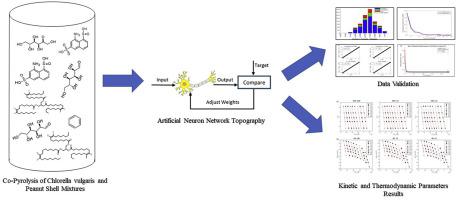Our official English website, www.x-mol.net, welcomes your feedback! (Note: you will need to create a separate account there.)
Artificial neural network approach for co-pyrolysis of Chlorella vulgaris and peanut shell binary mixtures using microalgae ash catalyst
Energy ( IF 9 ) Pub Date : 2020-09-01 , DOI: 10.1016/j.energy.2020.118289 Jang Tyng Bong , Adrian Chun Minh Loy , Bridgid Lai Fui Chin , Man Kee Lam , Daniel Kuok Ho Tang , Huei Yeong Lim , Yee Ho Chai , Suzana Yusup
Energy ( IF 9 ) Pub Date : 2020-09-01 , DOI: 10.1016/j.energy.2020.118289 Jang Tyng Bong , Adrian Chun Minh Loy , Bridgid Lai Fui Chin , Man Kee Lam , Daniel Kuok Ho Tang , Huei Yeong Lim , Yee Ho Chai , Suzana Yusup

|
Abstract The catalytic pyrolysis of pure microalgae (M), peanut shell wastes (PS) and their binary mixtures were analysed by introducing the microalgae ash (MA) as a catalyst. The pyrolysis processes were conducted at different heating rates from 10 K/min-100 K/min to observe their thermal degradation behaviour. Additionally, Artificial Neural Network (ANN) was applied by feeding the heating rates and temperatures to predict the weight loss of the samples. The kinetic and thermodynamic parameters were also determined through three different iso-conversional kinetic models: Friedman (FR), Kissinger-Akahira-Sunose (KAS) and Flynn-Wall-Ozawa (FWO). Based on the kinetic results, FWO model achieved the lowest deviation between the activation energies (Ea) from the experimental which aligned with the ANN predicted results. The finding also shows that the activation energy (Ea) of the catalytic pyrolysis of binary mixtures was lower than the pure M and PS (Experimental: 142.56 kJ/mol; ANN forecast: 131.37 kJ/mol).
中文翻译:

使用微藻灰催化剂共热解普通小球藻和花生壳二元混合物的人工神经网络方法
摘要 以微藻灰(MA)为催化剂,对纯微藻(M)、花生壳废弃物(PS)及其二元混合物的催化热解进行了分析。热解过程在 10 K/min-100 K/min 的不同加热速率下进行,以观察它们的热降解行为。此外,通过提供加热速率和温度来应用人工神经网络 (ANN) 来预测样品的重量损失。动力学和热力学参数也通过三种不同的等转化动力学模型确定:Friedman (FR)、Kissinger-Akahira-Sunose (KAS) 和 Flynn-Wall-Ozawa (FWO)。基于动力学结果,FWO 模型实现了与 ANN 预测结果一致的实验的活化能 (Ea) 之间的最低偏差。
更新日期:2020-09-01
中文翻译:

使用微藻灰催化剂共热解普通小球藻和花生壳二元混合物的人工神经网络方法
摘要 以微藻灰(MA)为催化剂,对纯微藻(M)、花生壳废弃物(PS)及其二元混合物的催化热解进行了分析。热解过程在 10 K/min-100 K/min 的不同加热速率下进行,以观察它们的热降解行为。此外,通过提供加热速率和温度来应用人工神经网络 (ANN) 来预测样品的重量损失。动力学和热力学参数也通过三种不同的等转化动力学模型确定:Friedman (FR)、Kissinger-Akahira-Sunose (KAS) 和 Flynn-Wall-Ozawa (FWO)。基于动力学结果,FWO 模型实现了与 ANN 预测结果一致的实验的活化能 (Ea) 之间的最低偏差。


























 京公网安备 11010802027423号
京公网安备 11010802027423号